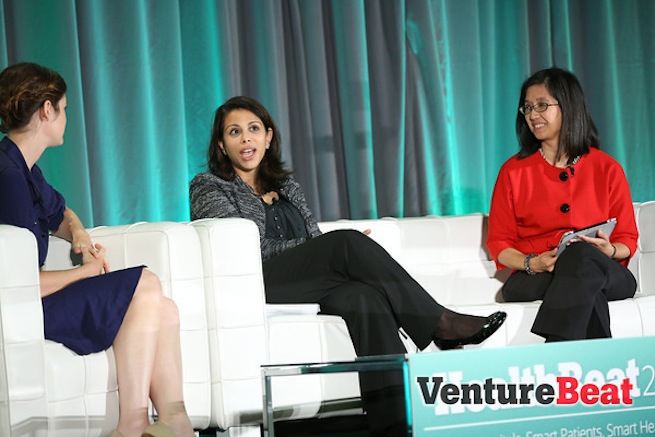SAN FRANCISCO, Calif. — What do the most innovative doctors and nurses really think about the new wave of medical technology?
[aditude-amp id="flyingcarpet" targeting='{"env":"staging","page_type":"article","post_id":741817,"post_type":"story","post_chan":"none","tags":null,"ai":false,"category":"none","all_categories":"business,","session":"B"}']While investors and entrepreneurs are making noise about opportunities in the space, health care providers are often the silent, reluctant partner. But to continue to stay at the top of their field, providers are keeping tabs on innovation and new products.
So we invited clinicians from Kaiser Permanente and Stanford University to HealthBeat to discuss the new technology they are piloting in their hospitals, and the gaps that entrepreneurs can fill.
AI Weekly
The must-read newsletter for AI and Big Data industry written by Khari Johnson, Kyle Wiggers, and Seth Colaner.
Included with VentureBeat Insider and VentureBeat VIP memberships.
“One of our big challenges is making ourselves accessible,” said Faye Karnavy Sahai, vice president of innovation at Kaiser Permanente (pictured above, right). But Kaiser has built its brand around innovation at the front lines of healthcare, and claims its 17,000 doctors and 49,000 nurses are exposed to new ideas across the spectrum.
“We also work independently with a lot of entrepreneurs and give them advice,” added Sumbul Desai (above, center), a doctor who works as the associate chief medical officer for strategy and innovation at Stanford.
To guide investment in the space, Stanford offers startup founders the opportunity to pilot their technology. A number of innovation fellowships are also available, and the hospital works closely with the accelerator program StartX Med.
“Every morning we’ll meet with folks in the entrepreneurial community — we love doing it and are super invested,” Desai said.
What are the biggest challenges for health entrepreneurs?
Desai said one of the biggest issues is that entrepreneurs don’t do their homework. There are unique regulatory, privacy and compliance issues involved with health care — HIPAA compliance is just the beginning. In addition, founders aren’t as aware as they should be about the competitive market.
The other challenge is integration. Desai stressed that new products need to work well with existing workflows. Kaiser is working on centralizing its electronic medical records (EMR) system, echoing a nationwide trend. To that end, Kaiser inked a deal with Epic Systems, the electronic health record company that health entrepreneurs have a love-hate relationship with.
[aditude-amp id="medium1" targeting='{"env":"staging","page_type":"article","post_id":741817,"post_type":"story","post_chan":"none","tags":null,"ai":false,"category":"none","all_categories":"business,","session":"B"}']
“Epic is the cornerstone of how we look at our data,” said Desai.
Epic has been criticized for hampering innovation due to its closed system that shuts out third parties. But it has a dominant position in hospitals, and isn’t wise to ignore.
Another issue the speakers raised is that entrepreneurs can often get too fixated on the idea, and not consider the organization that they plan to fit into. It’s easier said than done. So for this reason, startup founders like ConsultingMD’s Owen Tripp are opting to team up with physicians.
And the biggest opportunities?
One of the hottest areas is patient care, but Desai warned that it’s “just one piece of the puzzle.”
[aditude-amp id="medium2" targeting='{"env":"staging","page_type":"article","post_id":741817,"post_type":"story","post_chan":"none","tags":null,"ai":false,"category":"none","all_categories":"business,","session":"B"}']
Consumer technology is slowly making its way into hospitals. Kaiser is experimenting with putting real-time location data in sponges to prevent them from being left in patients’ bodies during surgery (and producing an ensuing publicity nightmare). In addition, nurses can check in using location proximity badges, making it far easier to track their movements.
Some of the less “sexy” areas include reimbursement and data analysis.
“Big data and analytics will be huge — expect to see predictive diagnostic capabilities,” said Desai. Much of this data will be mined from fitness trackers like FitBit and Jawbone’s Up, which are used by patients as part of a “quantified self” trend.
When asked about the one piece of technology that would be most beneficial, Desai urged innovators in the audience to think big. Physicians need “an overall digital experience,” she explained, that will clearly list out patient visits, second opinions, virtual visits, and so on.
[aditude-amp id="medium3" targeting='{"env":"staging","page_type":"article","post_id":741817,"post_type":"story","post_chan":"none","tags":null,"ai":false,"category":"none","all_categories":"business,","session":"B"}']
“Too often we see separate small companies and pockets of innovation right now,” she said.
Photo Credit: Michael O’Donnell/VentureBeat
VentureBeat's mission is to be a digital town square for technical decision-makers to gain knowledge about transformative enterprise technology and transact. Learn More

